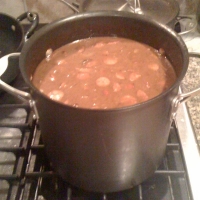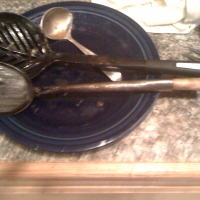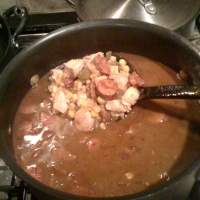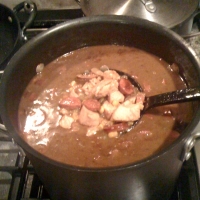Seafood Chicken And Sausage Gumbo
From grisha1 16 years agoIngredients
- 1/2 cup flour shopping list
- 1/2 cup olive oil shopping list
- 8-10 cups chicken and seafood broth. You can cook your prawns in 3 cups of water and use that as part of your seafood broth. For the remainder of the seafood broth we'll use all the original juices in the jarred oysters and clams. Place the clam juice from the can and the oyster juice from the jar along with the water the prawns cook in into the pot with the premade chicken stock. Be certain to measure this liquid mixture and for the remaining liquid mixture use a chicken stock. If you haven't a premade stock then you can use a canned chicken stock but I prefer creating a stock from a chicken based stock paste that can be made in minutes. These stock pastes are found in most supermarkets. shopping list
- 1 large onion chopped shopping list
- 3 stalks celery, chopped in 1/4 inch slices shopping list
- 4-5 cloves garlic chopped/minced shopping list
- 5 green onions, chopped shopping list
- 1 lb. frozen yellow corn, thawed and drained shopping list
- 5 andouille sausage, slices in halves or quarters shopping list
- 4 hot link sausage, halved or quartered shopping list
- 8 beef franks, sliced in 1/2 inch cuts shopping list
- 1 dungeness crab, in shell, cleaned and drained shopping list
- 1 jar medium oysters shopping list
- 1 can smoked - chopped clams shopping list
- 1 pound miniature scallops shopping list
- 1 pound prawns shopping list
- 5-6 chicken breasts, cut into one inch cubes shopping list
- 1 1/2 tsp dried thyme shopping list
- 1/2 tsp marjoram shopping list
- 1/4 tsp cayenne pepper shopping list
- 1/4 tsp garam masala shopping list
- 2 tbls creole seasoning shopping list
- 2-3 tbls seasoning salt shopping list
- 2-3 bay leaves shopping list
- 2 tbls file powder shopping list
How to make it
- The biggest part of creating this dish is all the chopping involved. I recommend cutting/chopping and precooking the meat ingredients first, and setting them aside in bowls/plates ahead of making your roux. Do the same by slicing all the vegetables and set them aside taking care to combine the onion and garlic in the same bowl as we'll be adding that to our roux first.
- Cook the chicken separately. You can basically stir fry the one inch cubes, but don't overcook it. Realize all these ingredients will continue to cook as they're simmering in the pot, so you're basically putting an edge on all the meat by precooking it before it goes into the pot.
- Set the cooked chicken aside in a bowl. I let it drain well in a collander. Combine the andouille sausage, wieners, and hot links together in a fry pan stir frying them for a few minutes until they're half done, taking care not to burn the wieners. Once cooked put into a collander and allow the grease to drain from them. We don't want too much oil from the hot links going into the pot so let this drain off for 10 or so minutes then set it aside in a bowl.
- Now that you've got everything cooked and chopped and ready to toss in the pot let's focus on making the base to this wonderful southern dish that's been in my family for over 80 years.
- First, preheat a tbls of olive oil until it's hot, then turn down the heat and saute your garlic and green onions together for a few minutes stirring constantly, being careful not to burn the garlic. Once cooked set aside until we've made our roux and once that's done this will be the first thing that goes into the pot.
- For this dish we're going to need a large pot or dutch oven style pot large enuf to accomodate all the ingredients. We'll use this same pot to make our roux base in. Realize that the roux is going to get VERY hot while we're making it, so you'll need a stirring object long enough to reach down to the bottom of the pot. BEWARE of spattering while stirring. I use a stir fry utensil (see attached photo) that's standard fare for any asian cooking and they're nice because they have wood handles that remain cool while the stirring portion of the utensil is iron. Whatever you use to stir the roux make certain that you don't use a plastic or wood utensil. I've tried both and trust me the roux will get so hot that a plastic utensil will begin to melt and a wood one will burn and begin to chip off. Trust me I've tried both and because of the high heat of the roux plastic and wood utensils do not stand up to the heat of a roux. Okay, now that we've got the proper utensils let's make our roux.
- Add your 1/2 cup of olive oil to the pot, crank up the heat to high, stir as you're heating the oil, about 90 seconds on a gas stove. Once your oil is hot, turn heat down to medium. Now begin your roux by stirring in a few tablespoons of flour at a time, stirring constantly adding a few tbls at a time until all flour has been added. Once a few tbls of flour have been dissolved by the hot oil add more, all the while stirring. Continue doing this in this amount until all flour has been added. Now all we have to do is stir making sure we scrape the bottom of the pot ensuring all areas of the pot are being stirred and no flour is burning. Don't begin your roux until you're prepared to stir until it's done. This is not a step where we can go answer the phone or have any distractions because if you're not stirring the roux will begin to burn and you'll know it's burned by black specs beginning to form atop it in addition to a burnt smell. Burnt roux results in burnt tasting gumbo, so this step is critical. For 1/2 cup flour and oil it generally takes me 20 minutes before I have a dark copper penny color on the roux.
- Here's a key secret to making a roux that i've learned through trial and error. Cooking over medium heat stirring constantly will create a copper penny colored roux in 35-40 minutes. You can cut this time in half by doing the following: Over medium heat once the roux begins to darken to the color of caramel, turn up the heat to 3/4 high. Once I turn up the heat I'm stirring rapidly and being sure to cover all areas of the bottom of the pot to ensure no areas stick or burn. Now with this higher heat setting here's the secret. It's going to get really hot, so as you stir watch for the first sight of smoke rising from the pot. Make sure your overhead fan is on to exhaust any smoke. The moment you see the slightest hint of smoke coming up from the pot slide it away from the heat and move to the side while continuing to stir the pot just as you've been doing. Don't stop stirring just because you've removed it from direct heat because trust me it's still cooking. What we're doing is allowing us to create the roux at a higher heat thereby cutting the cooking time needed to make the roux. Continue stirring until all smoke has dissapated, and then return to the heat, whilst continuing to stir. Removing it from the heat allows us to keep the temperature high whilst it's cooking without burning the roux. Again the moment I observe the first hint of smoke (which is a sign the heat is VERY high) I remove it from the heat, stirring continuously until the smoke has dissapated before returning to the heat. Going back and forth several times in this manner you'll create a roux without burning it in half the time it generally takes to make a dark roux. I've made roux over a 3/4 heat setting on a gas stove in as fast as 10 minutes. It's all in observing your smoke signals and removing it from the heat at the first sign of smoke. Before you know it you're looking at a medium penny copper brown roux ready to create your gumbo. Don't allow it to get too dark because the roux will darken 30-40 percent the moment you begin adding the vegetables below.
- Once you're done with the above and you've removed the roux from heat continue to stir, as the roux is still cooking even whilst removed from the heat. BEWARE, it's hot!
- Continuing to stir add the garlic-onion combo that you precooked. Be careful as it will now sizzle up on the bottom as soon as you add this. After stirring one minute then add the celery/onion perviously chopped. Adding the vegetables will cooldown the roux a bit and stop it from cooking, whilst seasoning the roux. Stir several minutes. You'll observe the roux darken 30 - 40% after the vegetables have been added. This is why we didn't make it too dark while we were making it before adding anything to it. We're just softening the vegetables and coating them with roux as we stir. You'll notice a carmelized coating to the veggies as you stir the contents of the pot. Toss in your cayenne pepper, continuing to stir for another minute. Now the roux whilst still hot is ready to add your chicken stock.
- Pour preheated stock into the roux carefully. Stir all ingredients mixing well. Set back atop medium heat . Immediately stir in your chicken and sausage combo. Next add all seasonings except the file powder. Cook over medium heat until it boils. Once it boils turn heat to lowest setting, and we'll simmer several hours. I allow it to simmer 2-3 hours, adding my corn, clams, oysters, scallops, prawns, and file powder the final 30 minutes. Important, don't allow the file powder to boil. Just make certain it's added during the last part of the simmer cycle and it'll be fine. File powder is not meant to boil. Yes, it can be boiled but it's not meant to be. Don't add the dungeness crab until the last 15 mins of cooking time because you're basically just heating it through. I make a pot of Basalmic white rice during the last 20 minutes of simmering time. It's a very nice and light rice which compliments gumbo just right. Enjoy!
People Who Like This Dish 2
- hungrybear Miner, MO
- ladybugdiva Dayton
- grisha1 Seattle, WA
- Show up here?Review or Bookmark it! ✔
The Groups
- Not added to any groups yet!





Reviews & Comments 0
-
All Comments
-
Your Comments